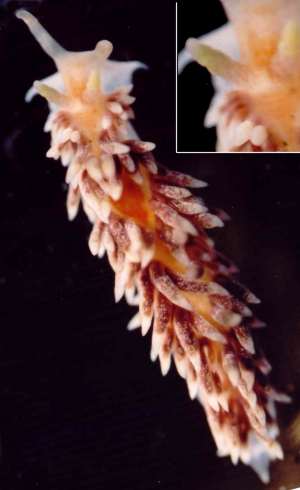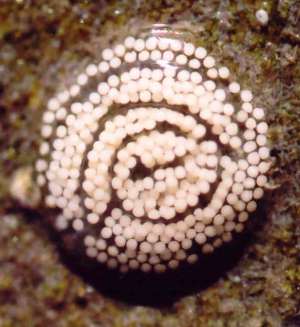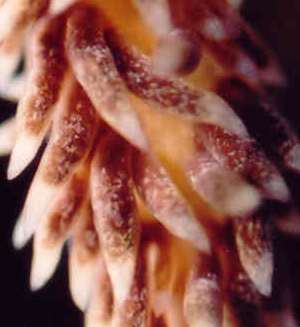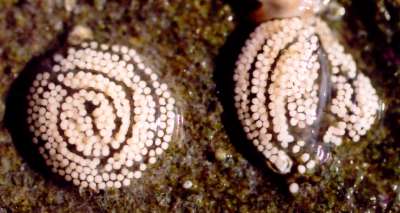Spurilla macleayi from New Zealand - with large eggs
September 6, 2005
From: Jeff Goddard

Hi Bill,
I was in Wellington, New Zealand recently, and while there I had a chance to do a little tide-pooling. I only found one species of dorid nudibranch (Aphelodoris luctuosa), one species of aeolid and one species of notaspidean, but the latter two finds have turned out to be fairly interesting, and I wanted to report here on the aeolid, which I believe is Spurilla macleayi. I found two specimens, both about 25 mm long and one of which was next to the two egg masses in the accompanying image (the previous day at the same locality I had found an identical egg mass, but no suspect as to who had laid it, so I noted the very large eggs and recorded in my notebook that they were probably laid by an aeolid). Given the proximity of the one specimen to the egg masses, as well as the paucity of other species of nudibranchs, I was confident that the eggs were laid by the aeolid I found. This was further confirmed when I later saw your message of 9 February 2004 [#12136] on the eggs and development of Spurilla macleayi. Small, unidentified anemones were common in the under-rock habitat in which I found the aeolids and were presumably their food.
Locality: Tarakena Bay, Wellington, New Zealand. Intertidal. Length: 25 mm (adult aeolid). 21 August 2005. Rocky shore, low intertidal pool. Photographer: Jeff Goddard
I collected the two egg masses and was able to borrow a microscope and micrometers from Victoria University of Wellington (thank you, Jonathan Gardner and Chad Hewitt). The embryos in one egg mass were slightly out of round, very yolky and opaque and averaged 480 microns in the longest dimension. They had relatively small, bluntly rounded velar lobes, no sign of a shell and occurred singly in capsules averaging 550 x 505 microns. Embryos in the second egg mass were at an earlier, but indeterminable stage of development and averaged 500 x 440 microns in size and also occurred one per capsule. In my experience the early embryos of opisthobranchs are usually close in size to that of the uncleaved eggs; these embryos therefore developed from some of the largest, if not the largest, eggs known in the Opisthobranchia.
These measurements complement your previous message on the direct development of this aeolid. Unfortunately, my visit was a short one, and I was not able to observe further the development of the embryos. I hope to return to your region before too long and continue there my comparative studies of developmental mode in opisthobranchs.
On a taxonomic note, I noticed that Miller (2001) does not include Spurilla macleayi from New Zealand, but does imply that it may be the same as S. faustina, which he does include from New Zealand. However, the Sea Slug Forum mentions the similarity of S. faustina to Aeolidiella drusilla, which is also described by Miller (2001) from New Zealand. Based on the images in the Sea Slug Forum, as well as Miller's (2001) description, A. drusilla appears to have a much wider foot than S. macleayi and S. faustina. Are macleayi and faustina synonyms, separate from A. drusilla?
-
Miller, M.C. (2001) Aeolid nudibranchs (Gastropoda: Opisthobranchia) of the family Aeolidiidae from New Zealand waters. Journal of Natural History, 35: 629-662.
Best wishes,
Jeff
goddard@lifesci.ucsb.edu



Dear Jeff,
This was certainly an excellent animal to find on a short visit to New Zealand, and its egg mass was an even more excellent bonus. It certainly is the animal we call Spurilla macleayi in Sydney, which is the type locality of the species. The drusilla / faustina problem is just another example of the chaos caused by naming species on the basis of single preserved decolourised animals. I can't even begin to understand why someone, even in 1900, could believe there was any point in giving these 2 specimens names, other than to build a score list of species names. We sometimes pay a high price for others egos. When Miller recognised the similarity of S. faustina to S. macleayi but because Burn considered the two were probably different, erred on the side of caution and identified his specimens from New Zealand as S. faustina. However your photos, and his description of the living animals are a clear match to some of the colour forms of Spurilla macleayi, and his radula drawing matches Bergh's S. faustina [see message #4159] and my SEM of typical S. macleayi [see message #12145]. I have discussed A. drusilla and S. faustina in earlier essages [#4159]. Because of the confusion I have A. drusilla on the Forum as Aeolidiella cf. drusilla but should really be confident and remove the 'cf'.
Yes Spurilla macleayi and Bergh's S. faustina are clearly synonyms. As Miller shows, it is quite different anatomically from A. drusilla, in many aspects of the body shape, including the cerata arranged in single rows in A. drusilla, rather than arches, and anatomically, in the radular morphology. As I said at the start of my comments, you couldn't have picked a better species to find.
Best wishes,
Bill Rudman
Related messages
-
Spurilla macleayi from northeastern New Zealand
From: Ian Skipworth, January 12, 2007 -
Re: Spurilla faustina? from New Zealand
From: Jeff Goddard, November 22, 2006 -
Spurilla faustina? from the South Island, New Zealand
From: Kimberley Seaward, November 21, 2006 -
Anemone-feeding nudibranchs in South Australia
From: Dennis Hutson, February 5, 2005 -
Spurilla macleayi from Tasmania
From: Bill Rudman, February 9, 2004 -
Spurilla macleayi from Sydney
From: Bill Rudman, February 9, 2004 -
Spurilla macleayi - eggs & development
From: Bill Rudman, February 9, 2004 -
Spurilla macleayi - colour variation
From: Bill Rudman, February 9, 2004 -
The radula of Spurilla macleayi
From: Bill Rudman, February 9, 2004 -
Spurilla macleayi - pink eggs?
From: Rachel Przeslawski , February 9, 2004
